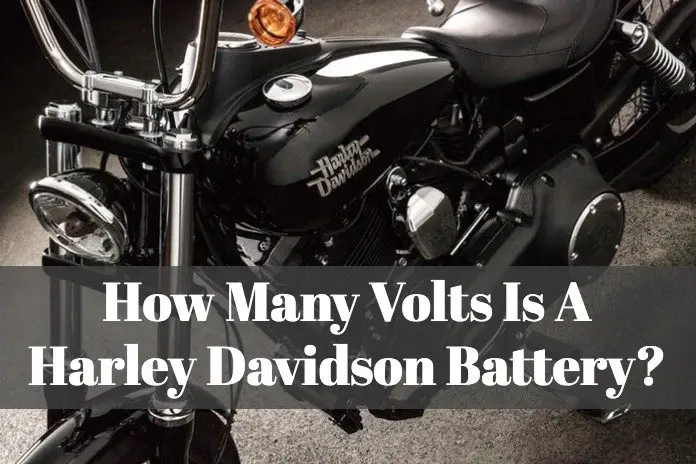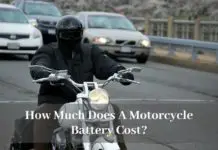
Harley Davidson is one of the most prestigious names in the motorcycle world. If you own a Harley Davidson motorcycle, you belong to the upper-class in the society. It is an American brand motorcycle which was founded in Milwaukee, Wisconsin in 1903.
It survived the Great Depression period of America during that time. Most people would like to know if it uses a particular battery to support its excellent design and power.
How many volts is a Harley Davidson Battery? Harley Davidson uses almost the same battery as the other motorcycle. Though they may recommend an individual cell for a Harley Davidson motorcycle, it is using a 12 Volts battery with a 12 Volt system. The complete battery specs for a Harley Davidson battery is 12V, 19 amp per hour and 270 CCA.
Most people think that Harley Davidson bikes are superior to other brands of motorcycle. They have the right to think so because, over the years, Harley Davidson was able to maintain its name in the motorcycle industry.
The excellent quality of design and performance is what counts. It is but practical to think that it must also be using a particular battery to maintain its superior and excellent performance.
How Many Volts Should A Harley Stator Put Out?
Everyone who owns a Harley must understand the components and the mechanisms even when it comes to its charging system. Every Harley Davidson has this charging components; the battery, its stator and the volt regulator.
Harley is differently designed and crafted from the regular motorcycle. It uses an alternator which is a permanent-magnet which keeps the battery fully charged. It is made up of a stator which is attach to the block of the engine and a rotor which is attached to the crankshaft.
The generator or the stator is the one that gives the magnetic field rotation the rotating armature.
The electric motor changes the rotating magnetic field to an electric current for a generator. For fluid powered devices, the generator is the guide to the flow of fluid to or from the rotating part of its system.
What If The Voltage Of Harley Davidson Battery Is High Or Low? What Will It Happen?
Harley Davidson bikes have a electric motor and a battery regulator. If it signals that your battery is registering to have a high voltage, there must be something wrong with your regulator.
The worst effect you can have with overvoltage is the danger of overheating the battery. The battery may explode anytime when you overcharged it.
However, when the level of voltage is low, still it doesn’t mean any good. You need to check everything with a voltmeter. The generator and the regulator can both be checked.
A low voltage battery may indicate drain or your regulator and stator might be having the problems. A shortened generator or electric motor may also be the culprit for a high or low battery voltage.
How To Check The Voltage Of A Harley Davidson
The Harley Davidson motorcycle’s volt regulator uses the AC which is supplied by the rotor/generator and changes it to a 12V DC. The battery regulator is usually located in front of the motorcycle and attached to a frame. It is one of the irreversible, and you should replace it once it is already worn out.
You need some special tools when you want to check its functions!
Tools You Need
1. Trouble light. A trouble light is a lamp that you used to illuminate dark places and can accept moderate abuse. The bulb is housed in a cage and has a handle which is molded to create a single unit.
It is also known as a drop light or an inspection light or a rough service lamp. It will help you see through a dark area when working on your voltage regulator system.
2. Digital Multimeter. A digital multimeter is used to measure more than one electrical values. It is a test tool which is used to measure the maximum voltage, current, and resistance. Most technicians used it as a standard tool in their electrical and electronic industries.
What Is The Volt Regulator?
A volt regulator is just an electrical device that limits the potential difference at a particular level of output. It is used to stabilize or regulate a voltage level. When you want a constant voltage, then you need a volt regulator to do it for you.
A volt regulator generates a fixed voltage that remains the same despite the changes in input voltage or loading conditions. The volt regulator acts as a protector of the components for any damages that may incur.
Two Types Of Volt Regulators: The Linear Type And The Changing Volts
Type 1. The Linear Type. It is the simplest and most straightforward type of regulator. This line regulator serves as the voltage divider. The volt regulator resistance differs with the load resulting in constant voltage output.
It has a two types of a line regulator: the Shunt and the Series. The line volt regulator also has its:
1. Shunt
Advantages:
● It gives a low output ripple voltage.
● It has a fast response time for loading or line changes.
● It is low in electromagnetic interference.
● It has less noise.
Disadvantages:
● Its efficiency is too low.
● It needs ample space.
● Its voltage cannot be filled in if above the input.
2. Series Volt Regulator
It uses a variable element which was arranged in series by a load. If you change the resistance of that particular series element, the voltage dropped across it can be altered.
The specific amount of current pulled out is positively used by the load. It is one of the significant advantages of a series volt regulator. The regulator in series does not draw out the full current making it more advantageous than a shunt voltage regulator.
Type 2. Changing Voltage. A changing voltage is a voltage regulating system that uses a changing form to change the incoming electrical supply to a certain voltage, which is used to even out the use of inductors and capacitors, as well as the other elements.
Symptoms Of A Bad Voltage Regulator On A Harley Davidson
If you have a bad voltage regulator, it can leave you stranded in the middle of the road. One of the most important things that you need to take care of in your Harley Davidson Motorcycle is your regulator.
The work of a volt regulator is to maintain the smooth flow of power supply to your motorcycle’s electrical system, and that includes the headlights, dashboards, the stereo and all the other things that consume electricity.
When any of these electrical parts failed or show signs of unpredictable failure of your engine, you have to check your volt regulator system. It will save you from the hassle of getting stranded from where you are.
I am going to give you the positive signs or hints that you have a bad voltage regulator!
1. Pulsating or Dimming Lights
Just like other vehicles, a dimming light is a symptom of a bad battery or alternator. In the same way, it will give away signs to a bad voltage regulator as well. A pulsating light or a dashboard system could mean that your voltage regulator is not working well.
2. Dead Battery
When your volt regulator is not functioning well, it will also reduce the battery’s capability to perform well. It may eventually lead to a dead battery symptom, which is also very common to other types of vehicles.
Once you recharge your dead battery, it will start immediately. However, your faulty volt regulator will easily lose the charge.
You must bring your motorcycle to the nearest mechanic. Have your battery recharged and you must replace the volt regulator at once or the same thing will happen again.
3. Unstable Engine Performance
Some problems originated from the manufacturing of the product itself. Errors will occur if the volt regulator of the vehicle is unable to handle the electrical power output of the vehicle alternator.
It causes the regulator to burn out easily because of overworking it. You can have it checked with your trusted mechanic.
Ways To Check Your Harley Davidson Charging System
There is an easy way to check your Harley Davidson’s charging system. For your AC output check:
1. You have to unplug the regulator from the generator.
2. You should start the motorcycle and change the voltmeter to AC volts.
3. You must probe both the generator wires using your meter leads.
4. When everything is done, your motorcycle must be putting up approximately 18-20 ACV per 1000 rpm.
I got some final advice! If your charging system is not working well, do not ride your bike yet. A dead battery may create all kinds of unwanted scenarios and situations.
If you are lucky enough, you can be one of those pushing their bikes against the traffic while waiting for a rescue to come.
Do Harley Davidsons Have Alternators?
Yes, Harley Davidson motorcycles have alternators. It is a part of the charging system of every Harley Davidson bike. The charging system consists of the battery, the voltage regulator, and the alternator.
The alternator consists of the rotor and the electric motor. It is tough to check the alternator visually as it is located on the other side of the engine chain case.
However, alternators are easy to troubleshoot and maintain. You can also quickly test it with a digital multimeter.
If we are only dependent on knowing how many volts is a Harley Davidson Battery, then we can only come to know that it is nothing more different than other regular battery.
However, looking deeper into the fact that Harley Davidson is crafted differently than other motorcycles make us think that there could also be a special mechanism to it than having the same voltage advantage with a regular battery.





